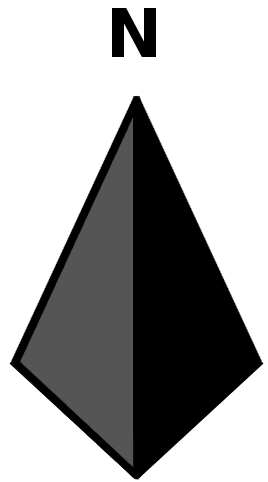When to use north arrows on maps
February 25, 2010 Filed under Blog, Presentations, Writing
 This topic came up in an e-mail discussion with Jon Zeitler, Science and Operations Officer at the National Weather Service Forecast Office in Austin, Texas. He advocated that maps should have horizontal length scales and north arrows on them. I agreed with him about the length scale, but felt that north arrows might be unnecessary because the maps we meteorologists usually use are plotted on a small domain that usually has north facing up or are large enough that the latitude–longitude lines will orient the reader.
This topic came up in an e-mail discussion with Jon Zeitler, Science and Operations Officer at the National Weather Service Forecast Office in Austin, Texas. He advocated that maps should have horizontal length scales and north arrows on them. I agreed with him about the length scale, but felt that north arrows might be unnecessary because the maps we meteorologists usually use are plotted on a small domain that usually has north facing up or are large enough that the latitude–longitude lines will orient the reader.
His response was a good one, one that I want you to see and think about.
I agree. However, there are some considerations:
1. We see more and more studies that combine meteorological data with data from other disciplines (geography, oceanography). While an ad hoc standard of map projections has developed for meteorological data, other disciplines have their own ad hoc (or agreed upon) standards. When combining data in a GIS system, it is essential to reproject everything in the same coordinate system to avoid matching errors. A north arrow may help to identify mismatches.
2. In a collaborative study with UT-San Antonio, we found a radar processing algorithm had shifted the entire polar domain one-half degree clockwise. Without a north arrow, it would not have been immediately obvious—entailing large errors at far ranges from the radar station.
3. Longitudinal parallax errors in satellite images (especially at large viewing angles), would seem to be minimized (or at least obvious and understood) by addition of a north arrow.
The addition of a north arrow can never harm a figure, only help with clarity. I’m flexible enough that if it’s presented on the first of similar figures, it can be left off subsequent frames. Also, some figures (e.g., a U.S. map with number of tornadoes per state) don’t need a north arrow. So, while certainly not as “required” as a distance scale, best practice would be to include a north arrow or compass rose.
In summary, include a north arrow on your maps if omitting the north arrow could give an ambiguous orientation to the reader or if including it would benefit the figure.



I would prefer to look at it the other way up.
When might/can/should a north arrow be omitted?
On a map where the projection causes significant variance in North (> 10 degrees)
Where a labeled and lined graticule gives obvious and unambiguous information NS
When there is no rational ambiguity about north (e.g national (some); land mass (NZ/Japan); continental; Global)
One out of three (might), Two out of three (can), Three out of 3 (should):